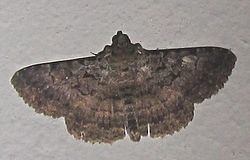Rank Species | ||
 | ||
Similar Polydesma, Achaea catella, Megalorhipida leucodactyla, Dysgonia torrida, Amyna axis | ||
The Monkeypod moth, (Polydesma umbricola), also known as Large Tabby, is a species of moth in the family Erebidae. The species is found in Southern Europe, Africa, minor Asia to Southern Asia, of India, Sri Lanka, Maldives, Andaman Islands, including many Indian Ocean islands, like Coëtivy Island, Aldabra, Assumption Island, Madagascar and on Hawaii.
Contents
In South-East Asia lives a similar species: Polydesma boarmoides.
Description
Wingspan about 50mm. Antennae of male minutely ciliated. Palpi with short third joint. Male with sub-basal area of hind wings clothed with long silky hair ventrally. Body brown suffused with fuscous color. Fore wings with indistinct waved sub-basal, antemedial, medial, and post-medial lines, each arising from a black spot on the costa. A crenulate pale sub-marginal line with some fuscous suffusion inside it. A marginal series of lunulate spots present. Hind wings with indistinct antemedial and medial sinous line. A crenulate sub-marginal pale line with fuscous suffusion inside it. A marginal series of lunulate spots present. Ventral side with the area inside the crenulate submarginal line of both wings broadly suffused with fuscous.
Ecology
Caterpillar is a serious defoliator of many plants across the world. Adult laid eggs near the tips of the terminal twigs. Newly emerged larvae fed on the tender leaves of the twigs. Six larval instars until pupa. Young larvae secrete silk threads from spinnerets and suspended themselves from twigs by them. This habit, and the discharge of a fluid from a saclike, eversible gland are the only known defense strategies. Pupation usually found within bark cracks and crevices. Older larvae and adult are nocturnal.
Larva known to feeds on plants like Albizia lebbeck, Pithecollobium dulce, Albizia saman, Acacia, Rosa, Salix.
